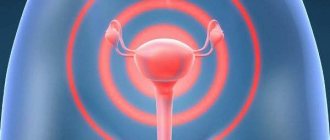Symptoms of conception before delay
The slightly increased size of the uterus begins to put pressure on the bladder, and the urge to go to the toilet occurs faster than usual. In addition, hormonal changes provoke the organ to work harder. If urination is accompanied by pain, then this is a symptom of cystitis, so it is important to consult a doctor for timely treatment.
Girls note that a clear sign of pregnancy on the 23rd day of the cycle, when you don’t even suspect an interesting situation, is intolerance to aromas. Some people run out of their offices when a plume of perfume comes from a colleague, while others cannot walk through the market where they sell fish and meat. Almost everything causes disgust - the smell of shoe polish, sweat, even the usual dishwashing detergent and soap.
Tears, apathy, affection, irritability and other feelings can change over the course of an hour. Although many girls feel nervous and hot-tempered before their period, experienced mothers claim that during pregnancy the mood swings are completely different and much brighter.
Sensitivity of the mammary glands.
The breasts increase in size, become heavy, and touching the nipples becomes quite painful. The venous network appears more than usual. The nipple halos may darken slightly; they will acquire a dark brown color later.
Progesterone, produced during pregnancy on the 23rd day of the cycle, slows down digestion, and therefore the intestines swell. As a result, girls cannot fasten their favorite jeans at the waist, although a couple of days ago they were just right.
The abdomen becomes larger in size as blood flow to the reproductive organs increases.
Nagging pain in the lower abdomen.
The sensations are similar to PMS discomfort.
A slight aversion to food indicates the onset of early toxicosis, which will continue until the end of the first trimester. This symptom appears on the 5-7th day after conception.
Low-grade body temperature.
Expectant mothers noticed that even before the delay, the thermometer showed 36.9-37.1 even without signs of a cold. This is considered a natural physiological response to progesterone production. If menstruation has arrived, then this temperature is a symptom of a sluggish inflammatory process.
Changing taste preferences.
As they say, it begins to “crave salty and spicy things.” This is the result of the same hormonal changes.
If you were planning a pregnancy and expect an expected conception, you should not take painkillers; it is better to take two Magnesium B6 tablets or, in extreme cases, Paracetamol.
Discomfort in the lower back.
Hormonal changes and increased blood supply to the pelvic organs cause a feeling of heaviness in the lower abdomen and lumbar region. There is a transformation in the architecture of the body, stretching of the ligaments for successful bearing of the baby.
It is expressed in two extremes - “wolf hunger” with uncontrolled eating of everything in the refrigerator, or indifference to food.
The body’s natural reaction is a decrease in immunity as a sign of pregnancy; on the 23rd day of the cycle or earlier, a girl may experience a runny nose, sore throat, and general malaise. At this time, the body is especially susceptible to viruses and various infections. If you suspect pregnancy, you should not take cold medications.
Increase in basal temperature.
The temperature is measured immediately after waking up. Without getting out of bed, the thermometer is inserted into the rectum. It is necessary to measure daily after ovulation. If 37.0-37.2 lasts until the end of the cycle, then pregnancy has definitely occurred.
Minor spotting discharge.
This is a sign of implantation of the fertilized egg, which, like a drill, penetrates the uterine cavity, and blood vessels are destroyed.
Dizziness and fainting.
Expectant mothers often lose consciousness in transport and in stuffy rooms. Low glucose levels and hypoxia in the early stages can cause short fainting spells.
Drowsiness and fatigue.
Have you stopped recognizing yourself? Previously, we completed all the tasks on the list, but now we only have enough energy for two or three items. Fatigue, daytime sleepiness and reluctance to get up in the morning are a clear sign that pregnancy has occurred.
While rebuilding, the body supplies most of the oxygen to the embryo, which can cause other organs to suffer. Therefore, when climbing stairs or while walking at an accelerated pace, breathing may become erratic and fatigue may set in.
A hormonal explosion leads not only to physiological, but also psycho-emotional changes, which makes it difficult to get enough sleep. The body seems to signal the emergence of life. It is acceptable to drink tea with lemon balm or valerian tablets at night, but no aggressive sleeping pills.
Signs of pregnancy at 2 months
With the onset of the second month of pregnancy, a woman has no doubt about her condition; she, with joy and some anxiety, tries to get used to her thoughts and mentally prepare herself for bearing and giving birth to a healthy baby. During this period, extremely important physiological processes in the formation of the child occur, so you should pay special attention to your health, and if there are any alarming signs, you should immediately contact a gynecologist.
At week 5, a woman experiences the following symptoms of pregnancy:
- In terms of psycho-emotional state, jumps and sudden mood swings, variability in desires and behavior are observed. Hysterics, attacks of tearfulness, apathy often occur, and attacks of blues and laziness appear.
- Appetite increases, taste preferences change, which are sometimes radically different from the usual.
- Sometimes attacks of nausea and vomiting occur, which can be triggered by various odors.
At week 6, the breasts increase in size, become heavier and the nipples harden. During this period, you suffer from increased fatigue, drowsiness and weakness, frequent urination, flatulence, and colic in the intestines may bother you. Slight weight loss is often observed, which is associated with toxicosis and morning vomiting. By the end of the second month, the ailments disappear, the body adapts to the new hormonal atmosphere, and the woman can enjoy her new condition. Preeclampsia is extremely rare.
What should you be wary of?
If pregnancy is planned and a woman suspects that she is pregnant, then the following symptoms should alert you:
- Influenza condition, diagnosis of sore throat, viral diseases. As a rule, this can cause fetal development pathology or fetal death.
- Cystitis. Infection in the genitourinary organs is undesirable.
- Clot-like blood or copious discharge of scarlet color. This may indicate a spontaneous miscarriage, when the uterus is cleared of an unattached egg.
- Cramping pain in the lower abdomen, discomfort in the lower back. This indicates hypertonicity, which is relieved by No-shpa, magnesia or Papaverine.
Any alarming signs and the fact that pregnancy was planned should be reported to the therapist. If treatment with antibacterial drugs is necessary, the doctor selects medications approved in the early stages. Self-medication is excluded.
Symptoms of ectopic pregnancy
Many people are concerned about the questions of what is an ectopic pregnancy, what are its first signs and how to determine the condition yourself in order to contact a medical facility in time? In order for the development of the fetus to occur according to physiological norms, the embryo must attach to the wall of the uterus. Sometimes it does not reach its destination and becomes attached to the fallopian tubes; this phenomenon is called an ectopic pregnancy.
Depending on the place of attachment of the embryo, the first symptoms may appear on the 20th day of the cycle (if the fetus is in the narrowest part of the fallopian tube) or after 8 weeks. It is easy to detect an ectopic pregnancy using an ultrasound. Under such conditions, the fetus cannot develop normally, so surgery is indicated to remove the embryo. How to determine ectopic pregnancy, symptoms:
- There is a delay in menstruation, but upon examination by a gynecologist, no fertilized egg was found in the uterus.
- A woman experiences scarlet, red or brown discharge from the vagina and suffers from sharp pain in the lower abdomen.
- Attacks of dizziness and fainting often occur.
- The hCG level is much lower than what it should be at this stage during a normal pregnancy.
Find out how to determine pregnancy without a test.
Lifestyle when planning pregnancy
With a 28-day cycle, signs of pregnancy on the 23rd day of the cycle become more noticeable. They are especially obvious for those who have already given birth or those who are looking forward to conception and listen carefully to their body. Women in early pregnancy are recommended:
- eliminate physical activity;
- do not lift heavy things;
- If possible, stop taking medications;
- do not visit crowded places and do not get too cold, so as not to catch a viral infection or cold;
- go to bed before 23.00, as this is important both for rest and for the production of progesterone;
- to walk outside;
- forget about the gym, as strength training can cause miscarriage;
- avoid stressful situations.
What discharge after ovulation, if conception has occurred, is considered normal?
According to doctors, it is impossible to independently determine pregnancy in the early stages. But, nevertheless, most women claim that they truly determined their position by seemingly insignificant changes and impulses.
Every woman monitors her health after conception with special attention. Women are especially worried during their first pregnancy. One of the first questions a woman asks is what discharge after ovulation, if conception has occurred, is normal?
After the birth of a new life has occurred, the quality and volume of vaginal discharge from a woman differs significantly from that of a non-pregnant woman. In this case, the discharge changes with increasing gestational age. Conventionally, according to time and nature, they are divided into three stages.
Undoubtedly, each person is individual. And what is considered normal for one may in no way affect another. So, some women do not notice changes in the body and find out about pregnancy already at a decent age.
Flu shot
This infectious disease is accompanied by severe complications - pneumonia, sore throat or sinusitis. Therefore, it is important to protect yourself from the flu, which in most cases leads to pregnancy failure or severe pathologies in the fetus.
Gynecologists at the stage of planning conception recommend getting vaccinated. A popular drug for French, which is approved even for expectant mothers and small children and has virtually no contraindications. Vaccination, as a rule, takes place in the autumn - October-December, before an outbreak of influenza occurs, so that the immune system has time to develop antibodies to the virus within a month.
It is important to remember that prevention is better than cure. What if conception occurs? On the 23rd day of the cycle, the formation of the internal organs of the embryo occurs, and various infections are simply dangerous for the unborn child.
Immediately after the birth of a new life
Conditional first stage of pregnancy. After fertilization, progesterone levels increase. And he, in turn, colors the discharge immediately after ovulation, if conception has occurred, white. White, almost transparent, odorless discharge is considered normal. They report the formation of a mucus plug.
In exceptional cases, women find creamy discharge after ovulation if conception has occurred. Such discharge is more abundant, more sticky and similar to the white of a raw chicken egg. It is worth noting that these discharges are also normal.
Precautions for chronic miscarriage
If a woman previously had a history of miscarriages and spontaneous abortions, then it is necessary to carefully listen to signs of pregnancy during a 28-day cycle. The 23rd day of the cycle is not yet a reason to buy a test, but if there is a slight delay, you should immediately do an analysis.
If the result is positive, you need to contact a gynecologist who will recommend donating blood for progesterone and hCG. If the levels are low, the doctor recommends luteal support - the drugs Duphaston, Utrozhestan, etc. Self-prescription of hormone-containing drugs is prohibited.
What to do if pain occurs in the middle of the cycle?
If the pain in the middle of the cycle is minor, then it can be relieved with the help of painkillers. Ibuprofen, No-Shpa, Ketanov will help. If a woman knows that she regularly experiences ovulatory syndrome, the pill can be taken in advance. On this day, it is necessary to minimize physical activity, drink more fluids, and give up heavy, gas-forming foods.
Sharp, severe pain requires a visit to the gynecologist. You cannot ignore it, because pain can be a sign of a dangerous disease.
Diagnosis of pregnancy before delay
Signs of pregnancy on the 23rd day of the cycle with a 30-day menstrual period can be pronounced, and the woman simply cannot wait to find out whether conception has occurred. There are determination methods for this.
Even more interesting:
The echo structure is not changed, what does this mean?
Tongue with pharyngitis photo
Highly sensitive test. Sold in a pharmacy. For accurate results, it is advisable to use morning urine.
Blood test for:
- progesterone (normal for the first trimester – 4.73-50.74 ng/ml);
- HCG (beta-HCL or human chorionic gonadotropin) - for women who are not carrying a child, the norm is 0-5 mU/ml, at the 3-4th week of pregnancy - 100-10000 mU/ml and the rate increases every week (if after a couple of days this the parameter dropped sharply, this indicates a frozen pregnancy).
Priority stats
Haste (up to cap) > Spell Power > Crit > Haste (above cap) > Int > Mp5/Spirit.
Speed limit: no raids: 434.
It's really easy for a DC priest to reach the speed limit because they already have 6% and 25% of their talents. Without any raid buffs, you will need 434 speed to be able to cast a shield every second. Having gone through so much haste, they would simply reduce the time for casting other spells. Another cap that people want to achieve is when Flash Heal is injected and there is a 1 second cast time without the Borrowe Time buff. This requires 1017 speed. Don't strive for it, though, and don't ignore it.
Int/Mp5/Spirit Value: In terms of mana regeneration, Intellect trumps both, so if mana is starting to drain quickly, go for it. Additionally, on lower GS gear, up until TOC raids, Intelligence trumps Spell Power. But only at low GS, when mana cannot be adjusted smoothly, and you need to rely more on Rapture.
A Spellpower Priest will be able to increase throughput and or mitigation, while a Priest with a gigantic mana pool will be able to stand for 10 minutes straight and may be the last healer with any mana left. If there is no mana source totem or only 1 source of replenishment (like in PuG or if one of their teammates died), a larger mana pool would definitely be useful.
Contrary to popular belief, MP5 is clearly no longer a better spirit for DC priests. Since as his equipment improves, the value of his spirit increases, because the spirit allows him to restore a percentage of his mana reserve. This means that the more mana/intelligence you have, the more useful the spirit will be.
If you are at level 264, take spirit instead of MP5 if you have boron. At levels below 264, use MP5.
Late ovulation
Typically, the egg is released 14 days before the menstrual cycle. The late process occurs in women with a long cycle, more than 32 days, and is not a sign of infertility. When ovulation occurred on the 23rd day of the cycle, is pregnancy possible? The process of conception and the course of pregnancy do not depend on the time of maturation of the egg. With late ovulation, there is a higher chance of having a boy.
Signs of pregnancy on the 23rd day of the cycle with a 28-day menstrual period or more can clearly indicate conception. But these will only be guesses and assumptions, because a 100% result will be given by a hCG test and ultrasound examination.
One week after conception
On the eighth day after fertilization, if the woman had a regular cycle, the fertilized egg attaches to the wall of the uterus. As a result, ruptures of one or more vessels are possible. Therefore, the discharge tends to be stained with blood. Thus, the selections receive a certain color:
- Bloody. The discharge is a colorless liquid with clots or streaks of blood, not voluminous and short-term. However, you need to be careful, because if the bleeding is prolonged and is not expected to stop, plus it is supplemented by painful sensations in the lower abdomen, these are alarming symptoms that indicate health problems. In this case, it is necessary to consult a doctor and carry out diagnostic procedures.
- Burgundy, closer to brown, discharge after ovulation, if conception occurred a week ago, is the norm. This color can be explained quite simply: in a certain group of women, the blood clots rather than leaves the uterine cavity.
The very first signs - can you feel them?
The modern world offers a large number of means of determining pregnancy in the earliest stages. Most often they are reliable in the first weeks after a missed period. Emotional by nature, women can feel the slightest changes in their body and even before the end of the menstrual cycle, suspect signs of the birth of a small life.
They are unlikely to name the exact date of conception, and the beginning of each cycle is marked on the calendar. Obstetricians will use this day as a basis for calculating the duration of pregnancy and the upcoming birth. Women planning motherhood are more likely to determine their due date if they tracked ovulation, which often occurs in the middle of the cycle.
The frequency of the cycle is different for everyone, most often it is a 4-week period, but it can be shorter or longer. As soon as the fertilization of the egg has occurred, metamorphosis occurs in the woman’s body. For some, they do not immediately become noticeable, while others feel the slightest nuances of physiological transformation already on the 16th - 18th day of the cycle.
Menstruation or pregnancy?
Due to the fact that menstruation often begins with small discharge, a woman, due to inexperience, may confuse it with pregnancy. In order not to get confused and not to have false hopes for future motherhood, you will have to learn to distinguish between them. The main difference is that the discharge after ovulation, if conception has occurred, is not as abundant and darker in color.
But this method of determination is not suitable for women with scanty periods. In this case, the woman considers menstruation as implantation discharge and does not even think about the fact that life has already arisen inside her.
In addition to spotting, pregnancy can be determined by the following signs:
- Basal temperature will change upward. The average is above thirty-seven degrees. First the temperature decreases and then increases. This temperature jump is a consequence of the production of progestogen (a hormone responsible for increasing temperature) and the release of estrogen (a hormone that lowers temperature). The elevated temperature lasts for several days.
- Mild malaise, inexplicable laziness. Along with the temperature, fatigue accelerates. The woman thinks she has a cold. And fever and malaise are the first signs of a cold. Sometimes there is a really minor cold. This occurs due to decreased immunity. In the early stages of pregnancy, the use of potent drugs is strictly prohibited. Moreover, you should not self-medicate.
- Frequent urge to urinate. The feeling of fullness of the bladder should not be accompanied by pain, cramping, and so on. Otherwise, it’s worth visiting a urologist and getting tested for infections, since pain during urination and a frequent desire to visit the ladies’ room indicate the development of cystitis or urethritis.
- Drawing sensation in the pelvic area. Such sensations appear in a woman due to the fact that the uterus is enlarged and blood circulation increases.
- Increased appetite. An obvious sign of a newly conceived pregnancy. This does not mean that you will crave pickles, but many women report cravings for certain foods during pregnancy. Mother nature has arranged everything in such a way that a woman’s body itself determines when it should start eating more calories, as people say, “for two.”
- Breast sensitivity increases. This sign of pregnancy appears after two weeks after fertilization. However, some group of women cannot feel their breasts at all. In such circumstances, pay attention to the color of the nipples. A pregnant woman's nipples will become darker in color.
- There is a delay in menstruation, but there is spotting after ovulation if conception has occurred. Reviews from many women say that they did not notice any discharge at all.
- But there may be another reason. Erosion of the uterus can cause spotting after ovulation, if conception has occurred. What are they? This discharge is bright red and profuse due to the increased blood circulation of a pregnant woman.
The first ones are the most responsible and wonderful transformations
The zygote is a one-celled embryo that travels through the fallopian tube for about 6 days. His goal is a warm and nourishing womb. At the same time, the ovary produces the corpus luteum, which is responsible for the production of the necessary hormones that will support the onset of pregnancy.
Introduction into the uterine wall takes place on the 7th day (22 - 23 days from the beginning of the cycle). Light bleeding during these 2 days is possible, but not necessary.
On the 24th - 25th day of the cycle or on the 9th day after the birth of a new life, the fertilized egg is formed, its place is carefully guarded, and its outer layer gives signals about the onset of pregnancy with the help of the hCG hormone.
The new hormone in the body works like a skillful and experienced leader. All systems work hard:
This mechanism starts a miracle machine; it is no coincidence that women even before the delay assume a possible pregnancy.
How to alleviate a woman’s condition with algomenorrhea
- If algomenorrhea was caused by frequent uterine contractions, the girl should take medications that suppress prostaglanditis. Such drugs should only be prescribed by a doctor. The doctor also prescribes the appropriate dosage to the patient. Why can't you self-medicate? There must be prostaglandites in the female body; if a girl takes an overdose of drugs that reduce their level, this will only worsen her condition.
- Algomenorrhea can be caused by dilation of the pelvic veins. This problem may be a side effect of uterine fibroids. This problem can only be eliminated through surgery.
How many days does it last for different cycles?
The ovulatory period occurs at different times for everyone, depending on their cycle. There is still no consensus on how long it will last. Some doctors believe that only 24 hours
, others are inclined to figure
48 hours
. The generally accepted duration is 24-36 hours.
The menstrual cycle consists of follicular, ovulatory and luteal phases. The follicular period lasts from the first for the cycle until the beginning of ovulation, ovulatory is the process of the release of the egg
, then the luteal period begins, which lasts until the onset of menstruation.
After menstruation, they are present in the ovaries with a size of no more than 10 mm. Only one begins to ripen
and increases to 20-25mm. This is the dominant follicle. When exposed to hormones - and luteal - the follicle bursts, the egg is released into the abdominal cavity. After this, it enters the uterine tube. After fertilization, the cell moves through the tube to the uterus, where it becomes attached. If fertilization does not occur, the egg dies.
Considering the lifespan of sperm
in a woman’s body (5-7 days), the possibility of occurrence occurs a couple of days before release and persists for 24-36 hours after.
Duration of ovulation at:
- 28 day cycle - from 14 to 15 days.
- 29 day - from 15 to 16 days.
- 30 day - from 16 to 17 days.
Calculation of the day of ovulation, menstrual cycle and days favorable for conception and pregnancy.
Using this calendar you can calculate the days of ovulation
, that is, when the probability of pregnancy is maximum and determine the most favorable days for conceiving a child (boy or girl) without pharmacy
ovulation tests
to determine
the days of ovulation
.
The conception calendar helps women planning a pregnancy to calculate the days of ovulation and create a personal conception calendar
.
You can chart your female menstrual cycle months in advance! You will receive a menstrual calendar for 3 months, which will indicate: the day of ovulation
,
days favorable for conception
,
days for conceiving a boy and a girl
. Do not confuse the duration of menstruation (period) and the duration of the menstrual cycle! Interactive ovulation calendar: hover over a day on the calendar and read additional information.
Symbols
Large symbols
• Symbol of Power Word: Shield: Gives him PW: S healing, which crit is capable of, so he will cast Divine Aegis.
• Glyph of Confession: Reduces the AC of Confession by 2 seconds. This is the most used healing spell. No mental symbols.
The third one usually depends on his own decision and play style:
• Glyph of Flash Healing: His second most frequently used heal has 10% less mana cost.
• Symbol Prays Healing: Really useful to 1 in 10 people due to concentrated damage. Rather useless in 25 man raids because it's usually not worth casting PoH and other raid healers have better group healing.
Those that should not be used:
• Glyph of Sacred No: Sacred Nova only affects the group, making this glyph rather useless. The only environment where I can imagine this being useful is inside Frostmourne. But even then, it's more useful to use shields on your group than to spam that expensive heal.
• Glyph of Renewal: Increases healing received from Renewing, but also reduces uptime. Since one shouldn't use Renew often enough to get this glyph, I wouldn't recommend it. Reducing uptime will also make Renew less viable as it must be used more often. Don't try to be a super healer in the Discipline spec. Leave it to Holy Priest and Druid Restaur.
Small symbols
Symbol of the fiend of Darkness.
Levitation symbol.
These were the most common of them, although the small prista symbols are not necessary. The third one that is recommended to use is Glyph of Fortitude in case you have to fight back against someone in the middle of a fight.
How to calculate your menstrual cycle and ovulation date?
It is believed that 4-5 days before ovulation and 1-3 after it are the best days to conceive a child.
Therefore, for some women this is a kind of “protection” from an unwanted pregnancy, and for others who want to have a child, it is to use their chance for happiness. Doctors usually call special ones, which are sold in regular pharmacies, the easiest way to calculate the day of ovulation. They must be done in the middle of the cycle, counting the first day of the cycle as the date of the start of menstruation. For example, if your last menstruation began on October 15, then starting from October 27-28, you should start doing these tests.
The principle of their “work” is the same as that of pregnancy tests - a woman dips a test strip into her morning urine and gets the result - tests must continue until the second strip becomes as bright as the first. When both stripes become equally bright in color, it means that ovulation has reached its peak, and it is important not to miss your chance at this moment.
The most budget-friendly, but also time-consuming way to calculate the ovulation cycle is to measure basal temperature. How to measure? Every morning, for at least three months, without getting out of bed, insert a regular thermometer into the anus, and when the numbers after 36.5-37 degrees on it show from 37.1 to 37.5, it means the day of ovulation has arrived. This ancient method is most suitable for women with an already regular menstrual cycle, and is not suitable for very young girls and those women whose cycle is regulated by various oral contraceptives.
And finally, the ultrasound diagnostic technique. An experienced ultrasound doctor, even using an old machine, can easily determine the condition of the follicles in the ovary or the corpus luteum. However, it is not always possible to resort to this particular diagnosis.
The shortest cycles in women occur due to hormonal imbalances, and average only 21-23 days. However, the longest ones - about 34 days - are also a kind of violation. Let's look at each menstrual cycle and ovulation cycle in detail.
The cycle is 22-23 days. When is ovulation?
The menstrual cycle, which is only 22-23 days, is considered the lower limit of normal in women, and is associated primarily with hormonal disorders or diseases of the pelvic organs, which cause frequent bleeding. But it also happens that for a woman this is a variant of the norm, however, it is not possible to conceive a child with such a short cycle, since in such a short time the embryo cannot fully form and attach to the wall of the uterus. With such a short cycle, ovulation usually occurs a few days after the end of menstruation.
Cycle 25 days. When is ovulation?
With a 25-day cycle, it is also difficult to get pregnant, since it takes about 14 days for the embryo to develop and attach. The day of ovulation in such a cycle should be counted as follows: 25 (duration of the entire cycle) - 14 (mid-cycle) = 11 (day of ovulation).
Ovulation in a 26-day cycle
If a woman with such a cycle wants to get pregnant, then she simply needs to measure her basal temperature for several months and buy tests, since “catching” the right moment is already more possible, but still difficult. However, you usually need to calculate the ovulation date using the same scheme. With a 26-day cycle, it occurs on days 14-16 of the cycle.
The menstrual cycle is 28 days. When is ovulation?
The menstrual cycle of 28 days is standard and most favorable for conception. In healthy women, such a cycle indicates that they are ready for pregnancy. Usually the ovulation cycle in this situation does not have “jumps”, and strictly three days before and after ovulation, that is, from days 11 to 17, a woman can safely become pregnant.
The cycle is 29 days. When is ovulation?
A 29-day cycle is also considered normal, and ovulation can also occur from days 11 to 17 of the menstrual cycle.
The menstrual cycle is 30 days. When is ovulation?
With such a long cycle, just like with a very short one, it is difficult to track ovulation, but it is possible. You need to rely on your feelings from the 14th to 20th days of the cycle, and when you feel an increase in libido, or there is a viscous, colorless discharge from the vagina and the stomach is stretched, it means that you can successfully conceive a child.
The cycle is 33-34 days. When is ovulation?
It is believed that with such a long cycle it is almost impossible to get pregnant, because there is too little time left for the development of the embryo. Ovulation in such a long cycle occurs approximately on days 20-25. Doctors unanimously insist that such an ovulation cycle needs to be corrected with hormonal drugs. However, some women manage to “get” to happy days and conceive a baby.
Dear women! If you are planning a baby, then do not despair if your ovulation cycle is too long or too short. You just need to see a doctor who will correct this phenomenon with appropriate treatment, and everything should work out for you!
Good afternoon, Tatyana!
There is nothing wrong with the regularity of the menstrual cycle; on the contrary, it is very good. A cycle of 26 to 36 days is considered normal, but even a cycle of 21 days can be considered normal, provided that the woman has regular menstruation.
The duration of menstrual bleeding is considered normal if it lasts no more than 6 and no less than 3 days. The amount of blood lost should not exceed 80 ml. A delay of 5 days in gynecology is considered normal, since most often it is associated with a restructuring of the menstrual cycle. Many women suffer from cycle instability rather than stability, so you can only envy you.
A cycle of 28 days is considered ideal, the reason is that a woman’s menstrual cycle is associated with the lunar cycle, which also lasts 28 days. A woman’s menstruation, like all phases of the cycle, is subject to hormones and changes precisely under the influence of hormones.
The menstrual cycle has 3 main phases:
- The follicular phase is the period when the follicle matures in a woman’s ovaries.
- The ovulatory phase is the period of ovulation, when the ruptured follicle releases an egg ready for fertilization and it enters the fallopian tube.
- The luteal phase of the cycle is the period before the onset of menstruation.
In addition, the mechanism of menstruation is such that throughout the entire cycle the level of hormones in a woman’s blood increases, because It is the sharp drop in this level that causes the onset of menstruation. According to gynecologists, the cycle is not as important as its stability; if the cycle “jumps”, then this fact may indicate pathology.
Undoubtedly, the cycle may undergo some changes, and most often you have experienced such changes yourself. For example, the cycle can shift due to stress, physical activity, during surgery associated with blood loss, illness, sudden weight loss, or a change in climate zone.
If your cycle is unchanged even in such conditions, then this may be alarming, since a woman’s hormonal background is very “capricious”, the “fine tuning” may go wrong, but even this kind of situation does not indicate any danger at all. Often, stability of the menstrual cycle is observed in women who take oral contraceptives; in this case, everything is quite understandable.
As I already said, menstruation begins when the level of hormones in the blood sharply decreases. When taking oral contraceptives, the level of hormones in the blood decreases automatically exactly when you take a break from withdrawal. In this case, it is quite difficult to influence the menstrual cycle, because while the woman is taking OK, it does not shift and does not undergo significant changes.
Each woman’s body is quite individual; it is not worth judging a specific case in a general framework. If you are concerned about the gynecologist’s words, you can consult again with another specialist. You don't need to panic about this. To be sure, donate blood for hormones in the luteal phase of the cycle or a profile for hormones; an ultrasound will also not harm.
These examinations in your case are rather of a preventive nature.
If there are no other accompanying symptoms, then cycle stability cannot be regarded as a pathology.
Best regards, Veronica.
The menstrual cycle is a phrase familiar to, perhaps, every woman. But not everyone understands what this cycle is, how it should be calculated and why. Let's look at this issue.
The menstrual cycle is not an entirely correct definition; it would be more correct to say the monthly or menstrual cycle. Its definition is simple - it is the period of time from the first day of the last menstruation to the first day of the next. Attention - the cycle is not counted from the end of menstruation, but from its first day! The average duration of the menstrual cycle is 28-35 days. If your period starts more often than every 21 days, or less often than once every 35 days, this is no longer the norm. If pathologies are not identified through tests and examinations, some minor, most likely temporary, circumstances are to blame for cycle disturbances. To normalize the menstrual cycle, the doctor may recommend taking oral contraceptives for 3-4 months, of course, if the woman has no contraindications to them.
The vast majority of women planning a pregnancy know how to count their menstrual cycle. After all, having this knowledge, you can calculate the most favorable day for conception - the day of ovulation. In addition, knowledge of how to calculate the menstrual cycle is necessary for women being treated for infertility. They regularly provide all information regarding their cycle to the doctor. This is required to prescribe the correct treatment, as well as to monitor its (treatment) results.
What does a disruption in the menstrual cycle indicate? Sometimes this is considered normal, and sometimes - pathology. For clarity, we give examples. Menstrual irregularities are normal:
1. when establishing a cycle in teenage girls (within 2 years after menarche);
2. after childbirth (especially if the woman is breastfeeding);
3. upon the onset of menopause (hormonal levels change).
Abnormal, but often there are irregular periods after abortion (hormonal imbalance occurs). Menstruation may completely disappear with sudden and significant weight loss (menstruation stops due to a lack of estrogen caused by excessive weight loss). A menstrual cycle of 40 days or more occurs in women suffering from hyperprolactinemia (increased production of the hormone prolactin). Uncontrolled use of medications also rarely goes away without leaving a trace. And these are not all the reasons that lead to malfunctions in the female body.
But no matter what anyone says and no matter how scary it is, a regular menstrual cycle of 25, 35 days, without “errors,” is not so common. The female nervous system is too fragile. If not physical pathologies, then stress will definitely disrupt this “biological clock”. Therefore, do not worry about rare, minor delays.
| 07/09/2019 17:52:00 Is it possible to lose weight with spirulina? The extremely beneficial blue-green algae spirulina is popular in the fitness community. Bodybuilders have been taking this seaweed for a long time because its high protein content and other elements can help achieve muscle growth faster. But does spirulina help you lose weight? | |||
| 07/06/2019 10:36:00 These methods will help you lose weight quickly Summer is already in full swing, but you have not yet managed to lose all those extra pounds? We will tell you how to lose weight quickly. | |||
| 07/05/2019 21:53:00 Which foods fill you up and which foods make you hungry? When our stomach growls, we want only one thing - to eat. How does the body control hunger and satiety, and do satiating foods help you lose weight? Let's find out together! | |||
| 07/05/2019 10:56:00 How to successfully lose weight after 40 years? The older a person gets, the more difficult it is for him to lose weight - this is a sad fact. And for women it is even more difficult to maintain their figure, since at the age of about 40-45 years the insidious menopause occurs. But how can you resist this? | |||
Most physiological processes in a woman’s body occur unnoticed if they do not cause a feeling of discomfort and are the norm. This also applies to the reproductive sphere. Thoughts about what late ovulation is in a 28-day cycle usually occur to women who cannot fulfill the dream of motherhood. When hearing this medical term for the first time, many feel anxious. How justified is this worry?
Doctors by departments and offices
Ultrasound diagnostic room:
- Abdullaeva Madina Abdullaevna - Ultrasound diagnostics doctor, Room 219.
- Zenina Valentina Alekseevna - Ultrasound diagnostics doctor, Room 621.
- Kononova Galina Aleksandrovna - Ultrasound diagnostics doctor, Room 613.
- Malysheva Elena Viktorovna - Ultrasound diagnostics doctor, Room 613.
Consultative and diagnostic department:
- Aziev Nadir Saipulakhovich - Gastroenterologist, Room 801.
- Viechelli Evgenia Aleksandrovna - Pulmonologist, Room 813.
- Koroleva Lyudmila Lvovna - Endocrinologist, Room 618.
- Victoria Andreevna Maslennikova – Endocrinologist, Room 617.
- Podkopaeva Yulia Sergeevna - Allergist-immunologist, Room 303.
Department of Cardiology:
- Ilyina Olga Vyacheslavovna - Rheumatologist, Room 618.
- Fokina Olga Gennadievna - Cardiologist, Room 620.
Department of Radiation Diagnostics:
- Bartagov Alexander Borisovich - Radiologist, Room 421.
- Gerasimova Violetta Yanurovna - Radiologist, Room 816.
- Tikhonova Olga Semenovna - X-ray technician, Room 816.
Department of Medical Prevention:
- Akmaeva Elena Alekseevna - Nurse, Room 220.
- Alfimova Maria Valerievna - Ultrasound diagnostics doctor, Room 219.
Department of Medical Rehabilitation:
- Bazrova Irina Anatolyevna - Physiotherapy nurse, Room 306.
- Viktorov Alexander Alexandrovich - Massage nurse, Room 310.
- Grandson Raisa Gennadievna - Medical instructor. physical education, Room 520.
- Erokhina Nadezhda Aleksandrovna - Physiotherapist, Room 307.
- Narimanova Marina Yurievna - Physiotherapist, Room 309.
- Polyakov Mikhail Gennadievich - Physical therapy doctor, Room 524.
Department of Neurology:
- Kupryashkina Yulia Gennadievna - Neurologist, Room 815.
Department of Functional Diagnostics:
- Godich Evgenia Vladimirovna - Functional Diagnostics Doctor, Room 614.
- Markina Maria Aleksandrovna - Functional Diagnostics Doctor, Room 615.
- Nuriakhmetova Aisa Mikhailovna - Functional Diagnostics Doctor, Room 614.
Department of Surgery:
- Arakelyan Albert Zavenovich - Surgeon, Room 817.
- Akhtaev Gasan Gasanovich - Urologist, Room 802.
- Murzenok Marina Iosifovna - Coloproctologist, Room 804.
- Prichepa Vladimir Vladimirovich - Urologist, Room 808.
Otorhinolaryngology department:
- Bulgakova Anastasia Vladimirovna - Otorhinolaryngologist, Room 611.
- Minaeva Anna Viktorovna - Ophthalmologist, Room 610.
- Yurganova Maria Stepanovna - Ophthalmologist, Room 609.
Treatment room:
- Nanichkina Olga Leonidovna - Nurse in the treatment room, Room 715.
- Pishucheva Olga Mikhailovna - Nurse (nurse) of a general doctor. pract., office 424.
Therapeutic department:
- Bayramukova Zurida Anzorovna - General practitioner, Room 708.
- Bashkova Nadezhda Viktorovna - Nurse (nurse) of a general doctor. prakt., office 420.
- Maslennikov Alexander Valerievich - General practitioner, Room 707.
Therapeutic department No. 4:
- Patimat Abdulmanapovna Zagirova - District physician, Room 120.
- Klyots Lesya Nikolaevna - General practitioner, Room 120.
- Kotakhova Svetlana Vladimirovna - District physician, Room 406.
- Kudzaeva Zarina Kazbekovna - General practitioner, Room 415.
- Kurbanismailova Jamilya Magomedovna - General practitioner, Room 120.
- Kuteynikov Dmitry Evgenievich - local therapist, Room 412.
- Melikhov Sergey Andreevich - local therapist, Room 425.
- Sidorova Elena Vladimirovna - General practitioner, Room 401.
- Frolova Natalya Vladislavovna - General practitioner, Room 120.
- Shengelia Olga Georgievna – General practitioner, Room 414.
Therapeutic department No. 5:
- Vorobyova Marina Nikolaevna - Paramedic, Room 405.
- Gvaliya Givi Tamazievich - District physician, Room 403.
- Gvaliya Medea Grigorievna - General practitioner, Room 416.
- Ilyina Olesya Gennadievna - General practitioner, Room 425.
- Lisovskaya Lyudmila Anatolyevna - local therapist, Room 404.
- Malkina Lyudmila Andreevna - General practitioner, Room 402.
- Melnikova Galina Pavlovna - Paramedic, Room 501.
- Samotokhina Elena Rudolfovna – General practitioner, Room 403.
Traumatology and orthopedic department:
- Beschastnov Dmitry Valerievich - Traumatologist-orthopedist, Room 111.
Endoscopy room:
- Vlasova Svetlana Nikolaevna - Nurse, Room 601.
- Ivakhnenko Elena Viktorovna - Nurse, Room 605.
- Korshaev Vladimir Kimovich - Endoscopist, Room 601.











